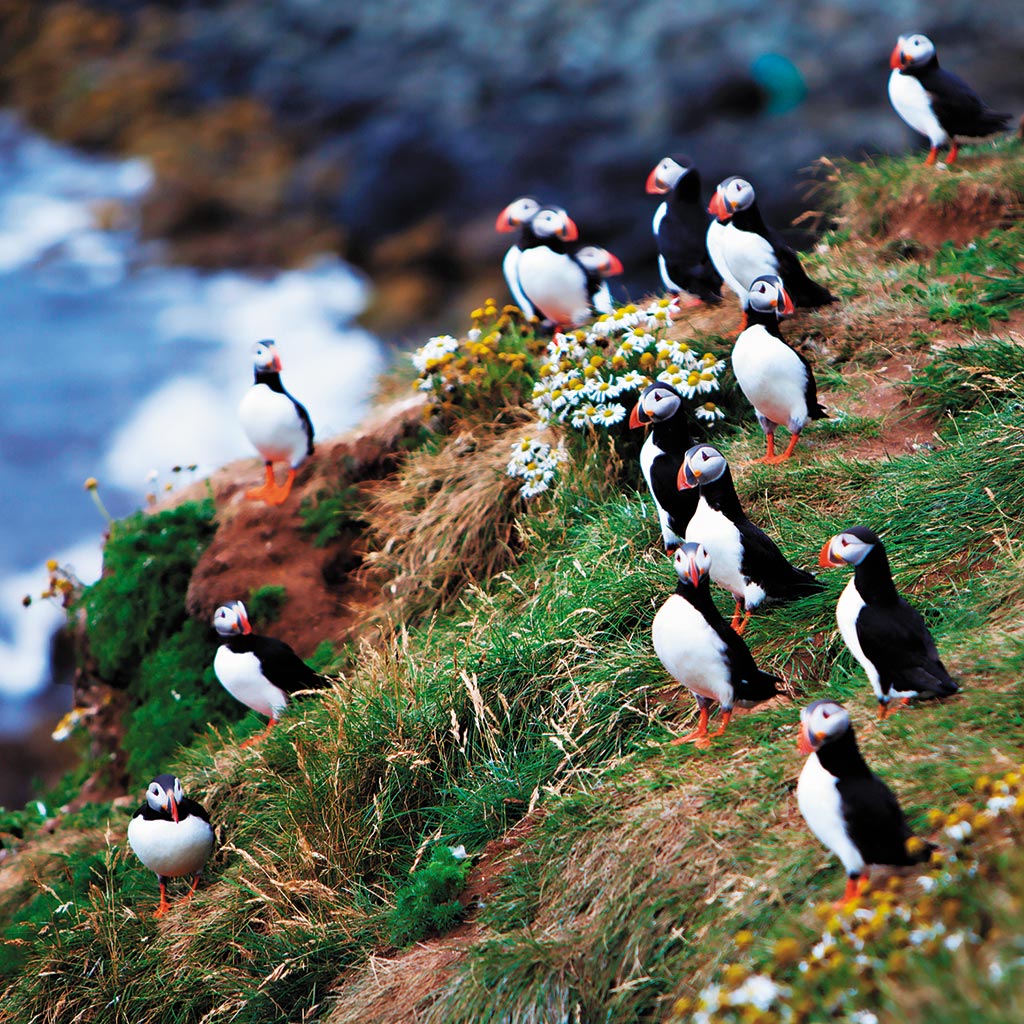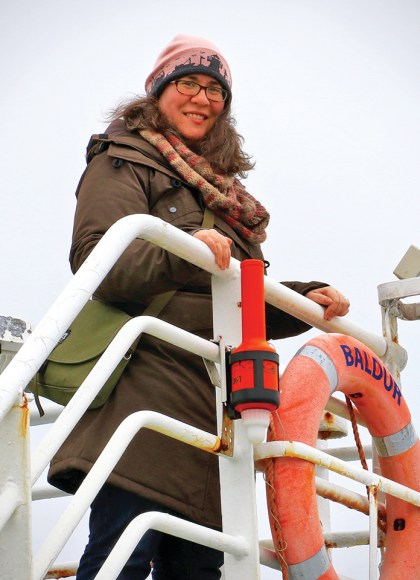Planning a Visit to Grímsey, Iceland’s Island of the Midnight Sun
About 40 km (25 mi) off the coast of Iceland, Grímsey is a windswept and secluded island, about 5 sq km (2 sq mi) in area, that is as striking in beauty as it is difficult to reach. Just 100 people reside in Grímsey, and those who remain come from hardy stock, battling arctic temperatures and isolation. Fishers brave the elements, including frost and storms and waves that can reach 15 m (49 ft) high. It’s not an easy life.
Visitors come to explore the tiny island, bird-watch, and experience 24 hours of daylight in the height of the summer. Night does not reach Grímsey until late July, when the sun sets around midnight, only to rise a short time later. The island can be explored in one day.
Sights

The Cliffs
East side of the island
The cliffs on the east side of the island tower 60-100 m (197-328 ft). In the old days, the basalt cliffs served as a major source of food, as locals collected eggs along the rifts. It was a tenuous task: A rope would be lowered 60 m (197 ft) down from the edge of the cliff while the individual collected eggs. There was a great risk that the rope would break or a large rock could break off, hitting and killing the climber. Today, the egg collection practice is safer and more modern, but the cliffs are a reminder of the past and their importance to the island’s sustenance. They’re also interesting formations and serve as a great backdrop when photographing birds.
The Lighthouse
Southeast corner of the island
Bright yellow and close to the cliff ’s edge, Grímsey’s lighthouse is one of the most significant buildings on the island. It was built in 1937 and is situated on the southeast corner of the island. It was originally operated manually with a gas lamp that had to be turned on and off by hand. Today, the lighthouse is automatic and still plays an important role in directing boat traffic along the coast. Although the lighthouse itself is closed to the public, the exterior is a popular place for photos, capturing birdlife and the cliffs in the background.
Crossing the Arctic Circle
Want to witness the midnight sun? That’s when the sun remains above the horizon for a full 24 hours around the summer solstice on June 20 or 21. There’s only one place you can experience this phenomenon in Iceland: where the Arctic Circle crosses the country’s northernmost point on Grímsey. If you’d prefer nearly 24 hours of darkness, there’s always polar night, on December 21.
A small symbolic bridge crossing the Arctic Circle can be found at N 66°33°, north of Grímsey’s airport terminal and next to Guesthouse Básar. Beside the bridge is a pole showing the distance to many well-known cities in the world, including London and New York.
Tourists who make the pilgrimage can buy evidence of their trip in the form of a diploma in the local gift store Gallerí Sól (Sólberg 611; tel. 354/467-3190; gullsol@visir.is; Mon., Wed., Fri. June-Aug.). You can also reserve your diploma at Gallerí Sól by phone or email. Diplomas cost 1,000ISK; those who come to Grímsey on a tour receive a diploma free of charge.
Festivals and Events
Summer Solstice Festival
www.visitakureyri.is/en; June; free
The summer solstice brings nearly 24 hours of complete daylight to Iceland, and locals on Grímsey celebrate every June. The festival includes live music, markets, guided walks, a family scavenger hunt, and a seafood buffet. The festival is free, except for the seafood buffet, and is open to everyone.
Grímsey Day
www.grimsey.is; June
Grímsey Day is an annual festival that takes place over three days at the beginning of June each year. It focuses on old traditions from Grímsey, like collecting eggs from the cliffs, as well as enjoying seasonal local food, music, and art.

Bird-Watching
Grímsey is one of the best spots in North Iceland for bird-watchers interested in seabirds. The high season for birding is from April, when birds migrate to the island to nest, to August, when birds depart the island for warmer weather. Bird-watchers will have a chance to see arctic terns, black-legged kittiwakes, northern fulmars, razorbills, common guillemots, black guillemots, and murres. You can also see white wagtails, northern wheat-ears, and snow buntings.
The main attractions, however, are the adorable Atlantic puffins, as Grímsey is home to one of the largest colonies in Iceland. The birds, with their bright beaks and big personalities, are a delight to watch nesting and gliding along the cliffs. Be aware of eggs and be careful not to disturb nesting areas during the spring. Grímsey is a small island, and the best bird-watching spots are the cliffs that line the island.
Pools and Hot Springs
Grímsey Island Thermal Pool
tel. 354/467-3155; 8pm-9:30pm Mon.-Wed., 2pm-4pm Sat.; 1,300ISK
The Grímsey Island Thermal Pool is situated near the airport and is a quiet spot to take a dip. You likely won’t find crowds here, and the hours change often. For current hours, inquire at the tourist information office or at your guesthouse.
Newsletter Signup
By clicking ‘Sign Up,’ I acknowledge that I have read and agree to Hachette Book Group’s Privacy Policy and Terms of Use
Food and Accommodations
Guesthouse Gullsól
Sólbergi; 354/467-3190; www.gullsol.is; year-round; from 16,000ISK
Guesthouse Gullsól offers four single rooms and two doubles in a charming wood house, one of the oldest structures on the island. Rooms are small but clean and neat, and it’s the closest guesthouse to the main population area. Guests share bath facilities and have access to a fully equipped kitchen to prepare meals.
Guesthouse Básar
tel. 354/467-3103; www.gistiheimilibasar.is; year-round; from 22,000ISK
Guesthouse Básar, next to the small airport, is an eight-room guesthouse literally just steps from the Arctic Circle. Rooms are simple and neat, and amenities include a common TV lounge and a fully equipped kitchen. Breakfast is included, and lunch and dinner can be requested as well.
Information and Services
A few years ago, the towns of Grímsey, Hrísey, and Akureyri voted to become a municipality overseen by Akureyri. Tourist information and ferry fares and schedules for all three towns can be found at the tourist information center at Hof concert hall by the harbor in Akureyri.
Safety
Weather can be your greatest enemy on the island, with unexpected wind gusts and horizontal rain. Island law states that children under age 14 must wear a life jacket when in the harbor area, whether they are playing, walking, or about to board a ferry. The ferry staff provide life jackets at the harbor.
Getting There
By Boat
The Sæfari (tel. 354/853-2211; www.vegagerdin.is) operates ferry service between Dalvík and Grímsey (9am Mon.-Wed., Fri., and Sun. summer from Dalvík, 8pm Mon.-Wed., Fri., and Sun. return from Grímsey; 8,000ISK round-trip) five times a week in the summer and four times a week in the winter. It takes about three hours each way, and the ferry holds 108 people. Book in advance in the summer months; tickets can be purchased at the tourist information office (tel. 354/450-1050; info@visitakureyri.is) at Hof concert hall in Akureyri. Check the website for up-to-date departure information, as schedules can change due to weather.
By Air
The flight from Akureyri to Grímsey is one of the most beautiful 30-minute airplane rides you will ever take. The jaw-dropping views of the landscape make the trip feel too short. The landing is not for the faint of heart, as the small plane has to land on a minuscule strip of grass on an island that looks like a rock in the middle of the ocean. During summer (June-Aug.), Norlandair (www.norlandair.is) provides frequent flights to Grímsey, where the airport is within walking distance from town, from Akureyri (Urðargil 15; about 30,000ISK round-trip). For current departure times and ticket prices, check Norlandair’s website.
Getting Around
Walking is the easiest way to get around on this island. You can take a walking path around the island that takes 2-2.5 hours.
Pin It for Later


